Duncan, Trussell, and Walden reported the effect of nonionic surfactants on the Thiobacillus ferrooxidan leaching of chalcopyrite. The tests were conducted in 250-mL Erlenmeyer flasks containing minus 325 mesh chalcopyrite and a modified 9K medium at pH 2.5 and 35° C. The hypothesis tested in adding the surfactants was that the presence of a surfactant would allow the bacteria to achieve a more intimate contact with the mineral surface and thereby improve copper extraction. A portion of the results obtained in this testing is shown in table 1 for the nonionic surfactant Tween 20. The results supported the hypothesis that the nonionic surfactant aided the bacteria in contacting the mineral surface. When several copper sulfide ores were tested under the same conditions as the chalcopyrite mineral, copper extraction was increased by between 5 and 12 pct in two of the ores tested and was decreased by 5 pct in one of the ores tested. The other five ores tested showed no change in copper extraction with surfactant addition. A mineralogical analysis of the ores was not given, making a comparison difficult. Duncan and Trussell also tested the effect of Tween 20 on the bioleaching of covellite, chalcocite, and bornite. Surfactant addition did not change copper extraction from these minerals.
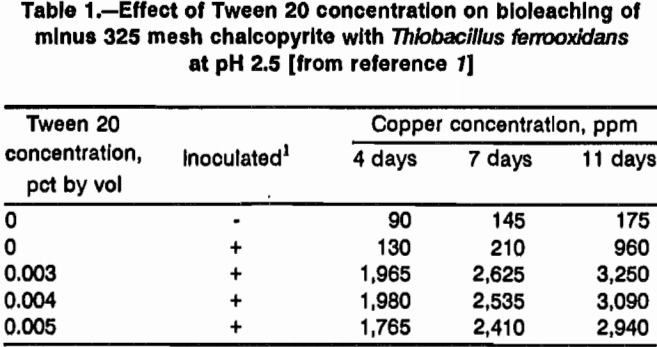
A possible explanation for the effect of the nonionic surfactant on chalcopyrite has unfolded recently since the collectorless flotation of chalcopyrite has come into clearer focus. Heyes and Trahar found that chalcopyrite became sufficiently hydrophobic to float in an oxidizing environment, but that nonflotability was exhibited in a reducing environment. Gardner and Woods reported that the presence of sulphur, which formed on the chalcopyrite surface as a result of anodic oxidation, was the critical factor in rendering the chalcopyrite floatable. More recently, Hayes and Ralston concluded that elemental sulphur is likely the cause of the observed hydrophobicity, and that the hydrophobic product is quite resistant to further oxidation. The natural floatability was observed to decrease only after extended periods of oxidation. Healy and Trahar have broadened the characterization of the hydrophobic product of oxidation to be an interfacial film that is sulfur rich or metal deficient or both. After considering this relatively new information on the collectorless flotation of chalcopyrite under oxidizing conditions in combination with Duncan and Trussell’s data, one can begin to formulate a hypothesis that the hydrophobic nature of chalcopyrite under oxidizing conditions interferes with the leaching of copper from chalcopyrite since in order for copper to be leached, the chalcopyrite must be oxidized. This oxidation is dependent on the interfacial contact between the chalcopyrite and the leaching solution. If a hydrophobic reaction product forms at the mineral-solution interface, then the ability of the leaching medium to wet the mineral surface would be decreased, thereby decreasing leaching. A nonionic surfactant would aid leaching by making the chalcopyrite more wettable.
On the basis of this hypothesis, the U.S. Bureau of Mines investigated the effect of nonionic surfactants on chalcopyrite leaching under conditions of temperature, pH, oxidant, and oxidant concentration that approximate those found in dump leaching. Dump leaching is a method to treat low-grade ore that is not suitable for treatment by flotation. The ore is placed in large piles of uncrushed run-of-mine material called dumps. The dumps are sprayed with dilute sulfuric acid, which percolates through the dump and is collected as it exists. The effluent from the dump contains copper and iron, the copper being recovered by cementation or solvent extraction, and the acidic iron sulfate being recycled to the top of the dump. Bacteria active in the dump oxidize Fe²+ to Fe³+ to provide oxidant for the leaching process.
It is in a chalcopyrite dump that the hydrophobicity-leaching hypothesis might be used to an advantage since the conditions in a typical dump favor the formation of a hydrophobic film on the chalcopyrite surfaces present in the dump. The leaching solutions utilized in a dump are mildly oxidizing. The solutions contain up to 2 g/L Fe³+ at a pH of between pH 2 and pH 3 and temperatures between 25° and 50° C. The chalcopyrite is stationary. There is no mechanical mixing. The solution percolates through the dump as a result of gravity.
The formation of a hydrophobic surface on chalcopyrite that resists wetting would contribute to the low recovery of copper being achieved in chalcopyrite dumps, and would pose yet another explanation for this low recovery.
Hiskey and Bhappu estimate that only 6 to 15 pct of the copper in chalcopyritic ores are recovered in 4 to 5 years of dump leaching. Explanations presented in the literature for this low recovery have included poor availability of oxygen, poor accessibility to copper in large rocks, and the formation of a passivating film on the chalcopyrite. A passivating film is one that inhibits leaching by preventing the electron transfer necessary for the leaching process. The passivating film has been attributed to the formation of elemental sulfur and to the formation of an intermediate copper sulfide on the chalcopyrite during leaching.
The research conducted by the Bureau showed that nonionic surfactants do improve copper extraction in the ferric sulphate leaching of chalcopyrite under dump conditions when sufficient Fe³+ is present, demonstrating a positive interaction between Fe³+ concentration and non- ionic surfactant concentration. At Fe³+ concentrations of 1.0 to 2.0 g/L, copper extraction was improved by as much as 100 pct by the addition of nonionic surfactants. At Fe³+ concentrations of 0.1 g/L, the nonionic surfactants decreased leaching by as much as 50 pct. Of the surfactants tested, Tween 40 was found to be the superior surfactant at 25° C, but became unstable at 50° C. A block copolymer nonionic surfactant, Tetronic 304, was selected as the superior surfactant at 50° C. It did not perform well at 25° C. An anionic and a cationic surfactant were found to decrease leaching over the Fe³+ concentration range of 0.2 to 1.0 g/L.
The present research was undertaken to identify a non-ionic surfactant that would perform well at 25° and 50° C and to further explore the extraction of copper from chalcopyrite as a function of Fe³+ concentration and nonionic surfactant concentration. Surfactant adsorption studies were conducted to determine the degree of nonionic surfactant adsorption by a typical chalcopyrite dump ore.
Materials and Procedures
Mineral leaching studies were conducted in statistical experiment design formats. The two experiment designs utilized were a “completely randomized” design and a 3×3 factorial design. The completely randomized design was used to compare the performance of four surfactants with each other to identify the superior performer. The statistical criteria used to identify a superior performer were the overall F-test and the Least Significant Difference (LSD) test (both as associated with analysis of variance) at the 0.05 level of significance. The F-test detected the presence or absence of a difference between the performance of two or more of the surfactants included in the completely randomized design, but did not isolate the difference or differences. The LSD test isolated the difference or differences by organizing the surfactants included in the comparison into homogenous subsets based on surfactant performance in promoting leaching. Those surfactants within a subset performed the same statistically, whereas those in separate subsets differed in performance based on the LSD test. A 3×3 factorial design was used to study the effect of surfactant concentration and Fe³+ concentration on leaching. The measured response was copper concentration in the leaching solutions as measured by atomic absorption methods. The data of a factorial design are typically analyzed by fitting a response surface model to the data using multiple regression procedures and then plotting the models to reveal the response surface. In this case, however, the response surface was found to contain several discontinuities that did not allow the fitting of a model. Therefore, the data of the factorial designs were plotted in x-y format and discussed qualitatively.
The mineral leaching studies consisted of ground chalcopyrite exposed to 50 mL of ferric sulfate leach solution in 250-mL Erlenmeyer flasks while being agitated in a reciprocal shaking water bath at constant temperature. The chalcopyrite was freshly prepared before each set of experiments by grinding to the mesh size required with a mortar and pestle and homogenizing on a rolling cloth. The chalcopyrite sample used was from Transvaal, South Africa. A mineralogical analysis revealed that the sample was approximately 88 pct chalcopyrite, 10 pct quartz, and 2 pct epidote with trace pyrite and bornite. Each experiment design consisted of from 9 to 16 flask tests. By homogenizing the chalcopyrite before loading into the flasks, each flask within a design received a sample of uniform particle size distribution in addition to equal mass. Because no effort was taken to insure a uniform particle size distribution between experiment designs, conclusions should be drawn within each design and not between designs. The leaching solutions were made with deionized- distilled water, reagent-grade ferric sulphate, and reagent-grade sulfuric acid. The nonionic surfactants tested were industrial samples obtained from their manufacturers.
The conditions of the completely randomized designs were 50 ppm nonionic surfactant, 2 g/L Fe³+, 1.0 pct solids, pH 2, and 8 days of leaching at 25° C and 50 ppm nonionic surfactant, 2 g/L Fe³+, 0.5 pct solids, pH 2, and 4 days of leaching at 50° C. The number of replicates used was three and four at 25° and 50° C, respectfully. A total of six 3×3 factorial designs was conducted. The conditions of the six factorial designs are presented in table 2. Designs 1 through 4 explore the response surface of copper extraction from chalcopyrite as a function of LA 790 concentration and Fe³+ concentration at 25° and 50° C using minus 100 mesh chalcopyrite. Designs 5 and 6 test the effect of LA 790 on different chalcopyrite particle sizes at 50° C. The design at 25° C was sampled after 6 and 12 days of leaching. The designs at 50° C were sampled after 2 and 4 days of leaching.
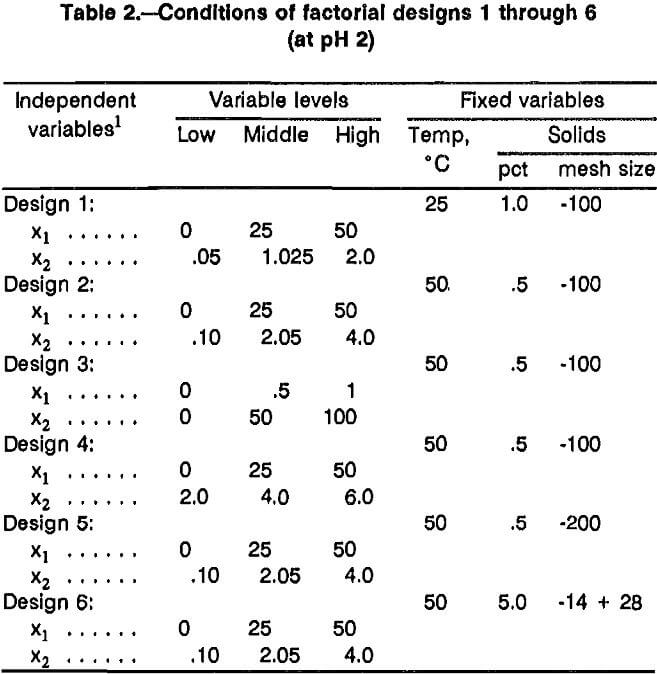
The nonionic surfactants selected for testing in this study are shown in table 3. The first five surfactants in the table are ethoxylated alcohols with an ether linkage between the hydrophilic polyethylene oxide group and the hydrophobic hydrocarbon group. The ether linkage is the most stable of the nonionic surfactant linkages. Each of the ethoxylated alcohols is a linear chain, except Arlasolve 200L, which possesses a branched hydrophobe. FC 760 is an alkoxylated fluorocarbon nonionic surfactant. The hydrophobe of FC 760 is a fluorocarbon chain compared with the other surfactants considered, which possess hydrocarbon hydrophobes. The fluorocarbon nonionic surfactants are reported to achieve a lower surface tension compared with the hydrocarbon nonionic surfactants. The surfactants are ordered in terms of their hydrophile-lipophile balance (HLB), which measures the molecular proportion of hydrophile in the nonionic surfactant molecule. The lower the HLB value of a nonionic surfactant, the lower the proportion of polyethylene oxide present in the molecule.
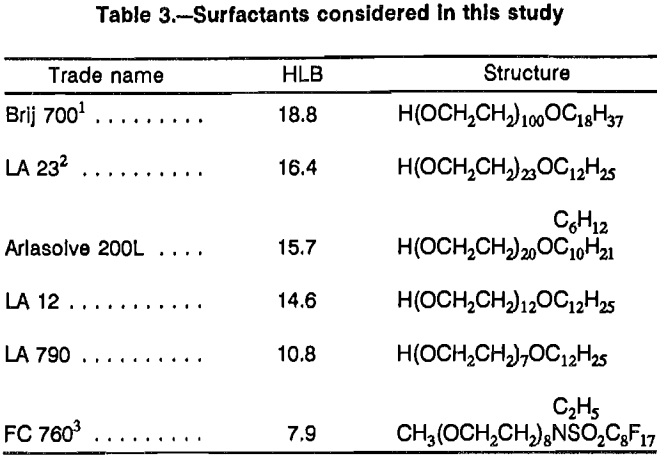
Surfactant adsorption studies were undertaken using a 26-cm-high by 3-cm-ID column. The purpose of the adsorption tests was to obtain an indication of how much surfactant would be adsorbed by a typical dump ore and whether some surfactants would be adsorbed less than others. For each test, 210 g of chalcopyrite ore obtained from Bingham Canyon, Utah, were packed into the column. A mineralogical analysis of the ore revealed that it was medium- to fine-grained hydrothermally altered igneous material consisting mainly of K-feldspar, quartz, biotite, and plagioclase. Sulfide mineralization consisted of disseminated chalcopyrite and minor pyrite. Ore fractions were blended so that the size distribution of the ore sample in the column was 57 pct plus 4 mesh, 29 pct minus 4 plus 14 mesh, and 14 pct minus 14 mesh. The ore sample was neutralized before each adsorption test with 50 mL of 184 g/L H2SO4. Neutralization of the acid-consuming constituents of the ore was necessary to prevent the Fe³+ in the feed solutions from precipitating out in the column. After neutralization, 400 mL of feed solution containing 100 ppm nonionic surfactant, 1 g/L Fe³+, and 3.7 g/L H2SO4 were percolated through the ore at 2 mL/min. The effluent from the column was collected in 30-mL volumes after the first 40 mL had passed through the column. The first 40 mL were used to rinse out the neutralization solution and were discarded. The surface tension of each 30-mL volume thereafter was measured using a Fisher Surface Tensiomat, Model 21. The presence of nonionic surfactants lowers surface tension. By measuring surface tension as a function of volume, the degree of surfactant adsorption was determined.
Results and Discussion
The results of the completely randomized experiment designs comparing Brij 700, LA 23, Arlasolve 200L, and LA 12 at 25° and 50° C are presented in table 4. The results are organized into subsets that do not differ in performance statistically based on the F and LSD tests. At 25° C, LA 12 and Arlasolve 200L perform the same statistically and are better in performance than LA 23, which in turn performs better than Brij 700. The performance of the linear chain ethoxylated alcohols at 25° C is correlated with their respective HLB values. The lower the proportion of hydrophile in the molecule, the more effective it is in promoting leaching at this temperature. Arlasolve 200L, with its branched hydrophobe, does not follow this rule. It possesses an HLB value of 15.7, but performs as well as LA 12, which has an HLB of 14.6. It will be shown later that the branched hydrophobe of Arlasolve 200L allows it to achieve a sufficiently low surface tension in the leaching solution so as to perform as well as LA 12. At 50° C, no difference in the performance of these four surfactants was uncovered. Although their mean responses are different, the differences are sufficiently small compared with the experimental error so as not to be statistically significant based on the F-test. The LSD test was not needed in this case since the F-test did not uncover any difference in the performance of these surfactants. At 50° C, the HLB of the surfactant does not affect leaching. Because LA 12 was the best performer at 25° C and produced the highest numerical response at 50° C, it was advanced to the second comparison.
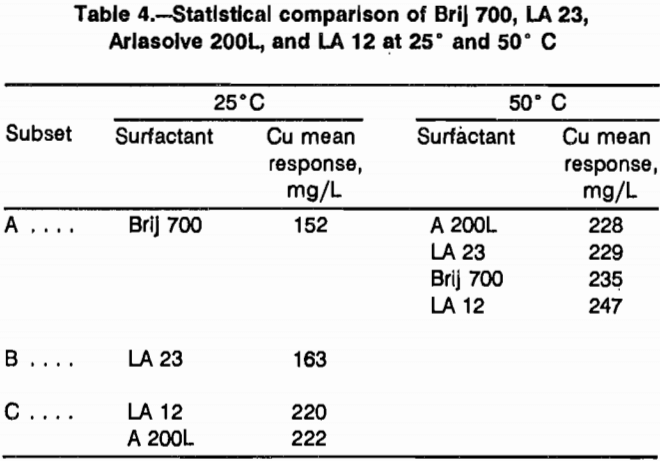
The results of the completely randomized designs comparing LA 12, LA 790, FC 760, and Tween 40 at 25° C and LA 12, LA 790, FC 760, and Tetronic 304 at 50° C are presented in table 5. Tween 40 and Tetronic 304 yielded the best results at 25° and 50° C, respectively, in the tests conducted previously. In table 5, LA 790 is the best performer of the comparison at 25° C. It outperforms LA 12 in keeping with the correlation previously shown between the performance of the linear chain ethoxylated alcohols and their HLB value. LA 790 exhibits the lowest HLB value attainable in the lauryl alcohol series while maintaining water solubility. If the HLB value is lowered further, the ethoxylated alcohol becomes oil soluble and water insoluble. LA 12 and LA 790 both perform better than Tween 40. FC 760, the alkoxylated fluorocarbon, is the poorest performer in this comparison at 25° C. In the comparison at 50° C, the four surfactants perform equally well statistically. Again, as in table 4, it is shown that at the higher temperature, the HLB of the nonionic surfactant does not affect leaching. Because LA 790 is the best performer at 25° C and performs as well as the other surfactants tested at 50° C, LA 790 was selected as the best performing surfactant at 25° and 50° C and was selected for further study in the factorial designs.
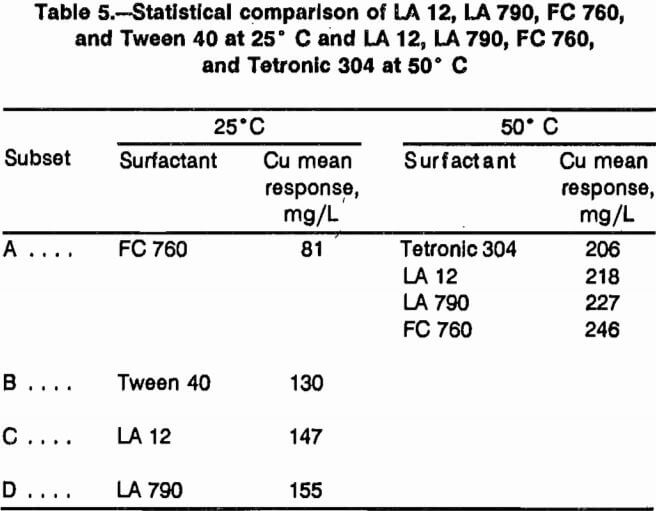
The results of factorial designs 1 and 2 are presented in figures 1 and 2, respectively. The addition of LA 790 increases copper leaching at 1.025 and 2.0 g/L Fe³+ at 25° C and at 2.05 and 4.0 g/L Fe³+ at 50° C. At 25° C and 1.0 pct solids, the increase is 116 pct after 12 days of leaching. At 50° C, 0.5 pct solids, and 4 g/L Fe³+, the increase is 61 pct after 4 days of leaching. Increasing LA 790 concentration from 25 to 50 ppm produces no further increase in leaching at either temperature.
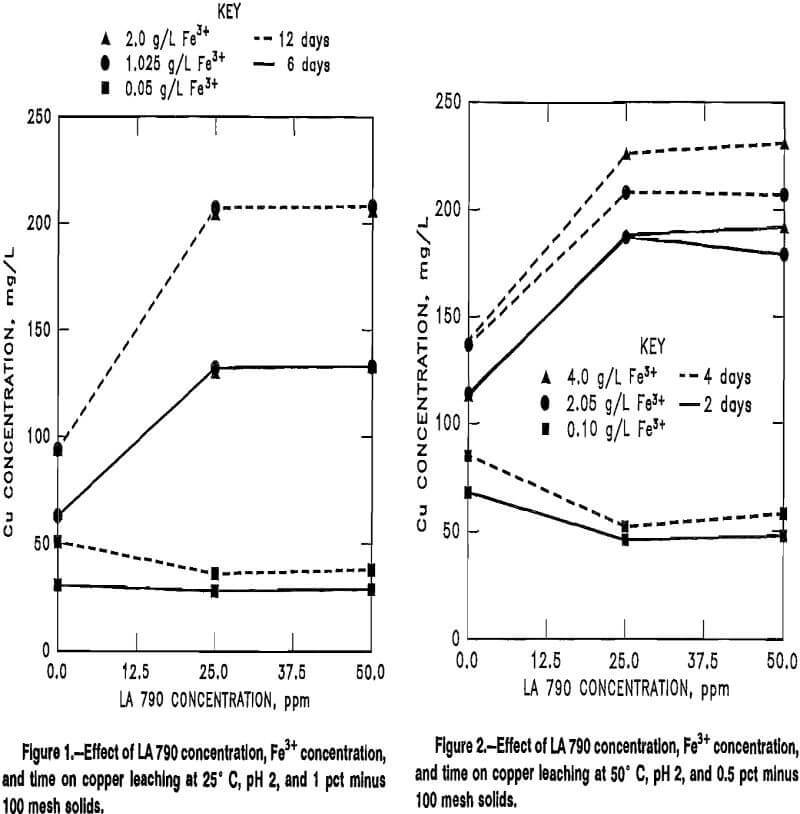
Increasing Fe³+ concentration from the middle to high levels at 25° and 50° C produces very little effect on leaching. At the low levels of Fe³+ concentration studied, 0.05 g/L at 25° C and 0.10 g/L at 50° C, the addition of LA 790 produces a decrease in leaching. The decrease is 24 pct at 25° C, 1.0 pct solids, and 12 days of leaching, and 35 pct at 50° C, 0.5 pct solids, and 4 days of leaching. Increasing LA 790 concentration from 25 to 50 ppm produces no further decrease in leaching at the low levels of Fe³+.
The underlying explanation of the positive effect of LA 790 is that the surfactant is rendering the hydrophobic chalcopyrite surface more wettable by the leaching solution. The negative effect of the surfactant at low Fe³+ concentrations will be shown in design 6 to be related to the chalcopyrite surface area present in the leaching test. The change in the effect of LA 790 as Fe³+ concentration is increased constitutes the positive interaction cited in the previous research. An interaction occurs when the effect of one independent variable is dependent on the level of another independent variable. In this case, the effect of LA 790 is dependent on the level of Fe³+ in the leaching system studied here. The fact that chalcopyrite leaching becomes insensitive to increasing LA 790 concentration indicates that the chalcopyrite surface becomes sufficiently wettable at a given level of surfactant.
Figures 3 and 4 contain data from designs 1 and 2, respectively, as a function of time. The purpose of the figures is to show that the presence of the surfactant does not prevent the passivation of the chalcopyrite surface during leaching. Passivation is represented by the leveling off of copper concentration with time. The chalcopyrite passivates at a higher level of copper extraction in the presence of the surfactant. Passivation is particularly evident in figure 4, which presents design 2 data (at 50° C) as a function of time. The fact that the presence of the non-ionic surfactant decreases the passivation of the chalcopyrite surface supports the conclusion that some of the passivation is due to a change in the wettability of the chalcopyrite as leaching progresses.
The hypothesis that the positive interaction between LA 790 concentration and Fe³+ concentration could be explained by the surfactant crowding out Fe³+ ions at low Fe³+ concentrations was tested in design 3 at very low surfactant concentrations. The variable ranges were 0 to 1 ppm LA 790 and 0 to 100 ppm Fe³+. Percent solids was increased to 1.0 pct, compared with the other designs at 50° C and 0.5 pct solids, to further decrease the ratio of surfactant to mineral surface area. The results are shown in figure 5. Even at LA 790 concentrations of 0.5 ppm, a decrease in leaching is observed at these Fe³+
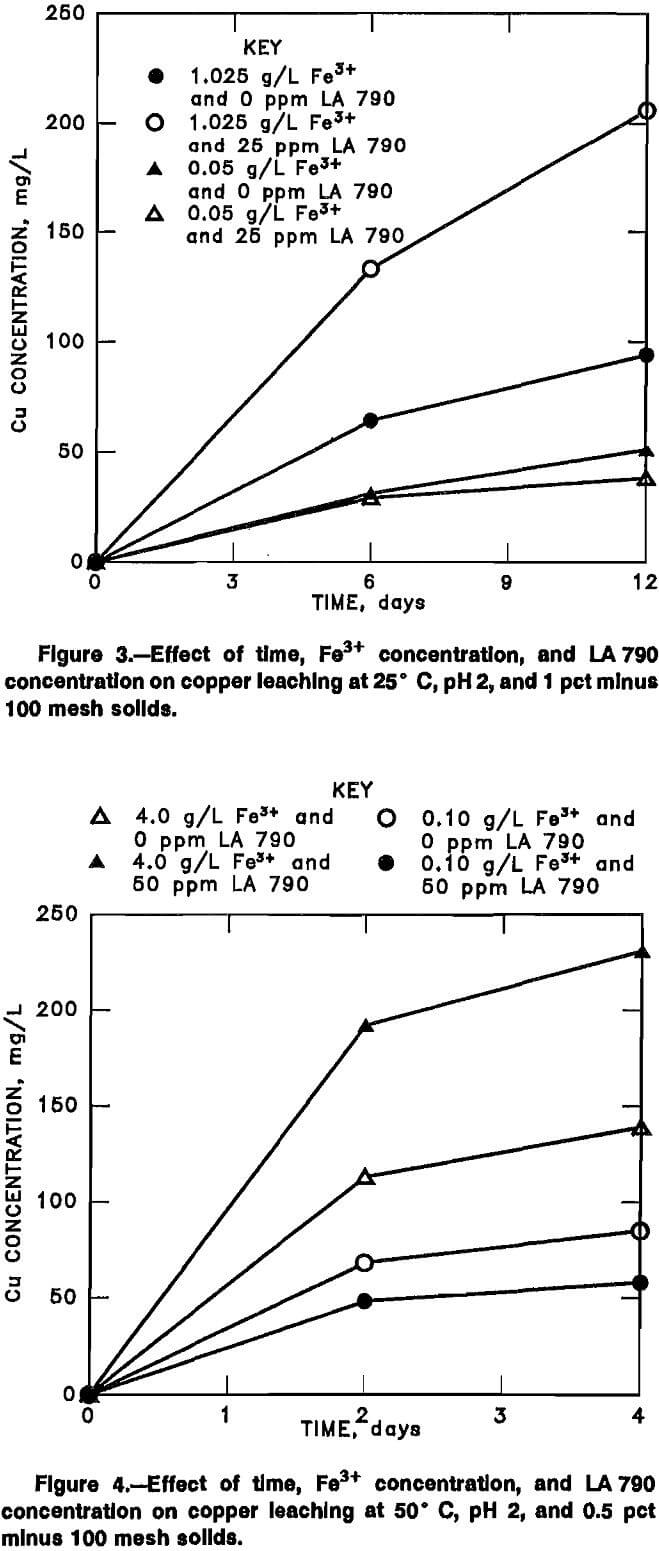
concentrations. In this case, the decrease is 20 pct at 0.5 ppm LA 790, 100 ppm Fe³+, and 4 days of leaching. The decrease in leaching diminishes as Fe³+ concentration
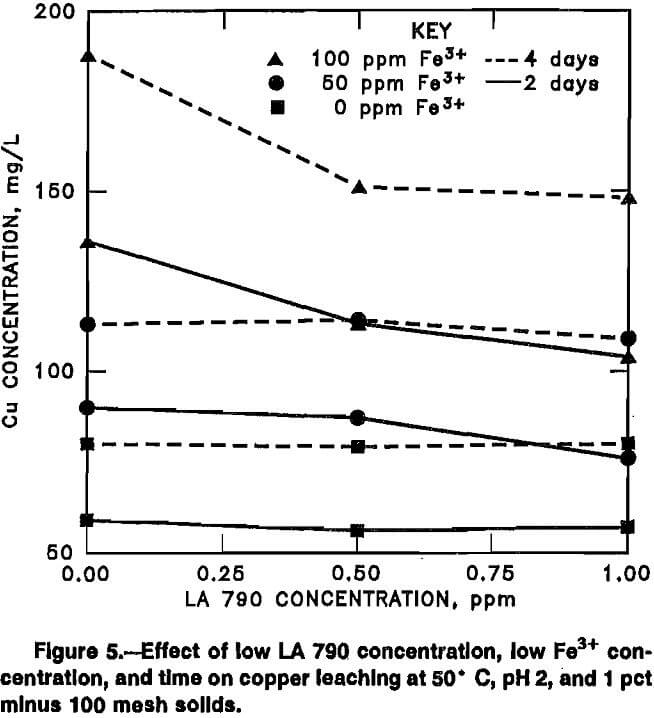
decreases. At 0 ppm Fe³+, the addition of the surfactant produces no effect on the leaching of the acid soluble copper in the chalcopyrite. Given these results, it is concluded that the surfactant is not crowding out Fe³+ ion.
The results of design 4 are shown in figure 6. This design evaluates the effect of LA 790 at Fe³+ concentrations of 2.00, 4.00, and 6,00 g/L. In figure 6, the addition of LA 790 performs equally well at the three levels of Fe³+ studied. Chalcopyrite leaching remains insensitive to Fe³+ concentrations beyond 2.00 g/L Fe³+.
Figure 7 displays the results of design 5, which tests the effect of LA 790 addition on the leaching of minus 200 mesh chalcopyrite. The figure shows that the effect of LA 790 on minus 200 mesh solids exhibits the same pattern of results as with the minus 100 mesh solids at 50° C, pH 2, and 0.5 pct solids. An increase in leaching is observed at 2.05 and 4.00 g/L Fe³+. A decrease in leaching is observed at 0.10 g/L Fe³+. The increase in leaching at 2.05 and 4.00 g/L Fe³+ is, however, larger with minus 200 mesh chalcopyrite than with minus 100 mesh chalcopyrite. At 4.00 g/L Fe³+ and 4 days of leaching, the increase is 94 pct with minus 200 mesh solids compared with 61 pct with minus 100 mesh solids. The decrease in leaching at 0.10 g/L Fe³+ and 4 days of leaching is approximately the same for both particle sizes, 31 pct with minus 200 mesh solids compared to 35 pct with minus 100 mesh solids.
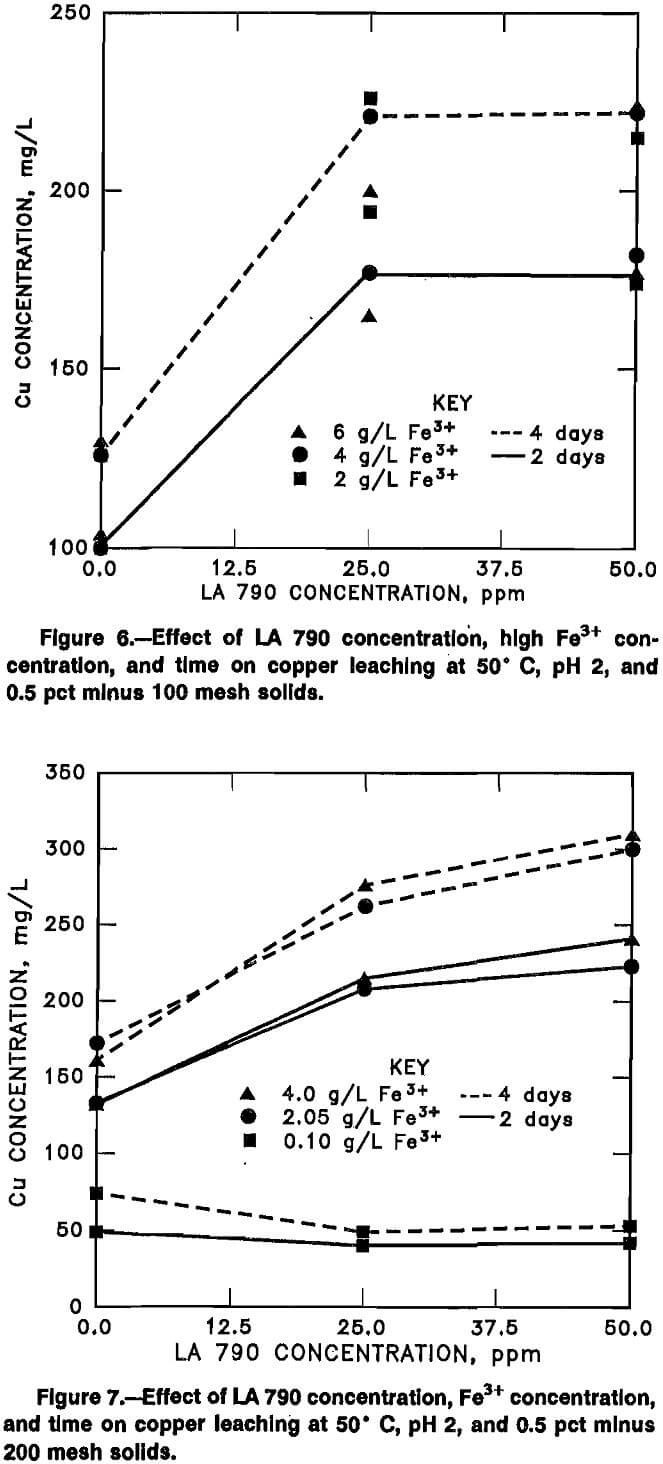
Figure 8, which shows the results of design 6, exhibits a different pattern of results than the other designs. Design 6 tested the effect of LA 790 addition on the leaching of minus 14 plus 28 mesh chalcopyrite particles. The principal difference in the results of design 6 compared to
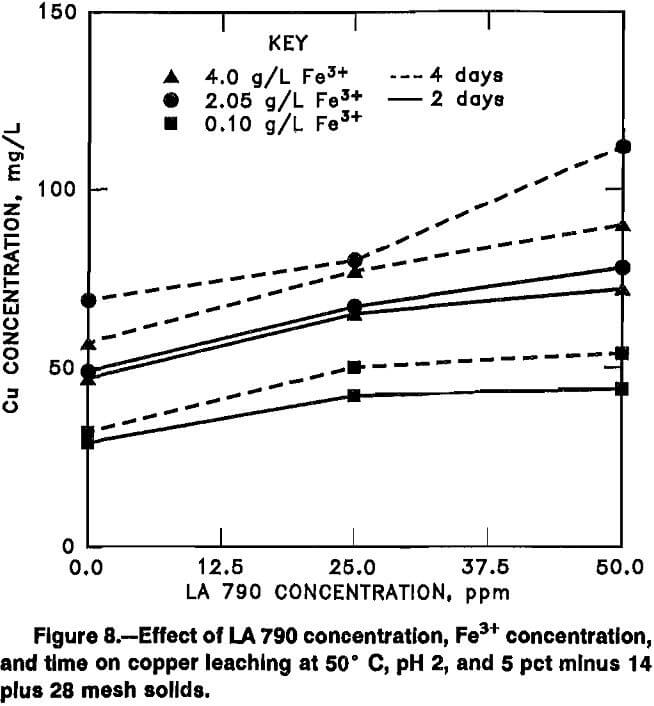
the other designs run under similar conditions is that at 0.10 g/L Fe³+, LA 790 addition produces an increase in copper extraction with the larger particles, whereas with minus 100 and minus 200 mesh solids, surfactant addition decreased leaching at 0.10 g/L Fe³+. Design 6 was repeated, except that 10 pct solids (minus 14 plus 28 mesh) were used. The results are shown in figure 9. In figure 9, at 0.10 g/L Fe³+, the addition of LA 790 again produces a decrease in leaching. These results indicate that the effect of surfactant addition at low Fe³+ concentrations is related to the chalcopyrite surface area. As chalcopyrite surface area is decreased, the effect of surfactant addition at low Fe³+ concentrations becomes positive.
The results of the surfactant adsorption studies are presented in table 6. All of the surfactants are heavily adsorbed by the ore in the column, regardless of HLB value. The change in surface tension from the feed value to that of the effluent from the column shows that even after 400 mL of a 100-ppm surfactant solution had passed through the column, each surfactant was still being removed from solution by the ore. Over the duration of each adsorption test, the surface tension of the column effluent remained at approximately that of distilled water at 20° C, which is 73 dyn/cm. Heavy adsorption of the surfactants by the chalcopyrite ore poses a serious barrier to their being applied to dump leaching because heavy adsorption would make the surfactants uneconomical to apply and perhaps ineffective.
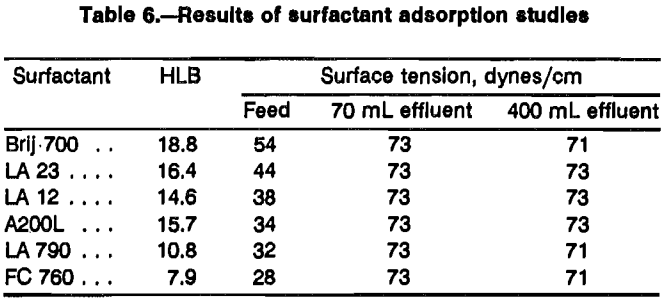
An interesting feature of the surface tension measurements is that the ability of the surfactants to lower surface tension is correlated with their HLB value. Those with lower HLB values lower surface tension to a greater degree than those with higher HLB values. Referring to the surfactant comparisons of tables 4 and 5, surfactant performance of the linear chain ethoxylated alcohols at 25° C was also correlated with HLB value. The linear chain ethoxylated alcohols with lower HLB values per¬formed better than those with higher HLB values. Arlasolve 200L with its branched hydrophobe, did not follow this rule. It possesses an HLB of 15.7, but performed as well as LA 12, which possesses an HLB of 14.6. In table 6, A200L produces a slightly lower surface tension than LA 12. This can be attributed to the branched hydrophobe of A200L, which allows it to produce a lower surface tension than comparable linear chain ethoxylated alcohols. The performance of the ethoxylated alcohols at
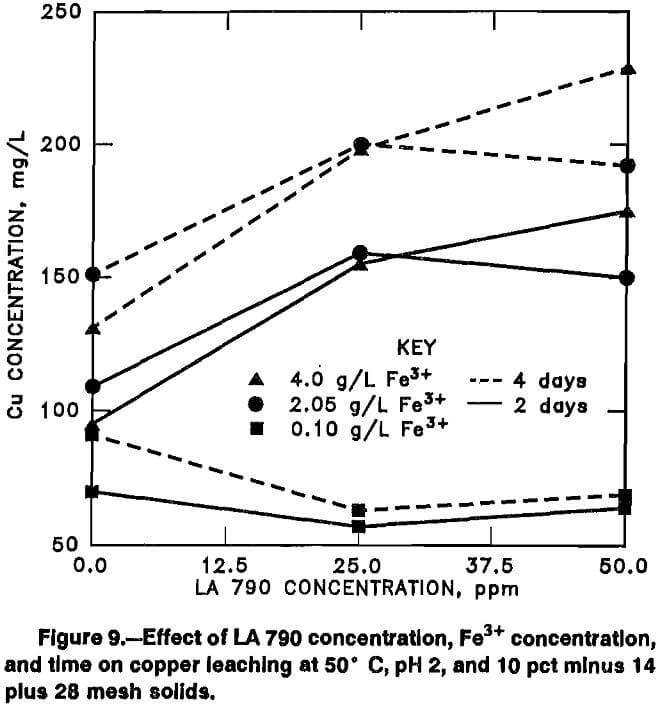
25° C is therefore correlated with their ability to lower surface tension. The fluorocarbon surfactant, FC 760, does not follow this correlation.
Conclusions
The nonionic surfactant LA 790 was selected as the best performing surfactant in the leaching of chalcopyrite at 25° and 50° C and was further studied in the factorial experiment designs. The performance of the linear-chain ethoxylated alcohols at 25° C was found to be correlated with their HLB values. At 50° C, the HLB of the surfactants was found to be unimportant in predicting surfactant performance.
The leaching of chalcopyrite was found to become insensitive to LA 790 concentration as this concentration was increased. The passivation of chalcopyrite towards leaching that occurs with time was explained in part by a change in the wettability of the mineral surface as leaching progresses. The increase in leaching due to LA 790 addition increased from 61 pct with minus 100 mesh chalcopyrite solids to 94 pct with minus 200 mesh solids under comparable conditions. The negative effect of surfactant addition at low Fe³+ concentrations was found to be related to the chalcopyrite surface area present in the leaching system. As chalcopyrite surface area was decreased, the effect of surfactant addition at 0.10 g/L Fe³+ became positive.
The surfactant adsorption tests revealed that all of the surfactants tested were heavily adsorbed by the chalcopyrite ore regardless of their HLB value. The ability of the surfactants to lower surface tension was found to be correlated with their HLB values. At 25° C, the ability of the ethoxylated alcohols to promote leaching was found to be correlated with their ability to lower surface tension. The fluorocarbon surfactant, FC 760, did not follow this correlation.
